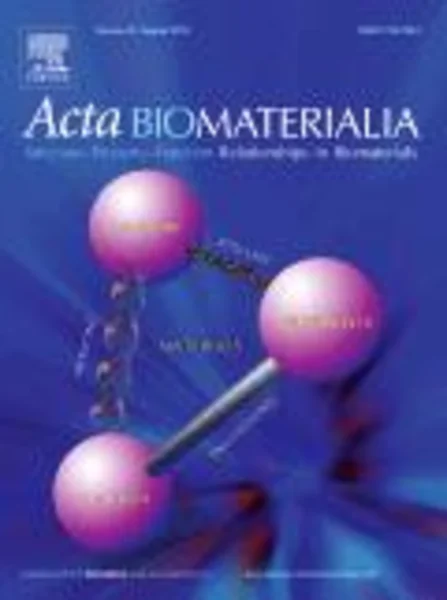-
co-culturing monocytes with smooth muscle cells improves cell distribution within a degradable polyurethane scaffold and reduces inflammatory cytokines
جزئیات بیشتر مقاله- تاریخ ارائه: 1392/01/01
- تاریخ انتشار در تی پی بین: 1392/01/01
- تعداد بازدید: 805
- تعداد پرسش و پاسخ ها: 0
- شماره تماس دبیرخانه رویداد: -
activated monocytes can promote inflammation or wound repair, depending on the nature of the implant environment. recent work showed that a degradable, polar-hydrophobic-ionic polyurethane (d-phi) induced an anti-inflammatory monocyte phenotype. in the current study it is hypothesized that wound-healing phenotype monocytes (activated by d-phi material chemistry) will promote human vascular smooth muscle cells (hvsmc) to attach and migrate into porous d-phi scaffolds. hvsmc migration is necessary for hvsmc population of the scaffold and tissue formation to occur, and then, once tissue formation is complete, the monocyte should promote contractile phenotype markers in the hvsmc. hvsmc were cultured for up to 28 days with or without monocytes and analyzed for cell viability, attachment (dna) and migration. lysates were analyzed for the hvsmc contractile phenotype markers calponin and α-smooth muscle actin (α-sma) as well as urokinase plasminogen activator (upa; pro-migration marker) using immunoblotting analysis. histological staining showed that hvsmc alone remained around the perimeter of the scaffold, whereas co-culture samples had co-localization of monocytes with hvsmc in the pores, a more even cell distribution throughout the scaffold and increased total cell attachment (p < 0.05). co-culture samples had higher cell numbers and more dna than the addition of both single cell cultures. the water-soluble tetrazolium-1 data suggested that cells were not dying over the 28 day culture period. calponin, also linked to cell motility, was maintained up to 28 days in the co-culture and hvsmc alone, whereas α-sma disappeared after 7 days. co-cultures on d-phi showed that monocytes were activated to a wound-healing phenotype (low tnf-α, elevated il-10), while promoting upa expression. in summary, this study showed that, by co-culturing monocytes with hvsmc, the latter showed increased total cell attachment and infiltration into the d-phi scaffold compared with hvsmc alone, suggesting that monocytes may promote hvsmc migration, a condition necessary for ultimately achieving uniform tissue formation in porous scaffolds.
مقالات جدیدترین رویدادها
-
استفاده از تحلیل اهمیت-عملکرد در ارائه الگوی مدیریت خلاقیت سازمانی و ارائه راهکار جهت بهبود
-
بررسی تاثیر ارزش وجوه نقد مازاد بر ساختار سرمایه شرکت های پذیرفته شده در بورس اوراق بهادار تهران
-
بررسی تأثیر سطح افشای ریسک بر قرارداد بدهی شرکت های پذیرفته شده در بورس اوراق بهادار تهران
-
بررسی تأثیر رتبه بندی اعتباری مبتنی بر مدل امتیاز بازار نوظهور بر نقد شوندگی سهام با تأکید بر خصوصی سازی شرکت ها
-
تأثیر آمیخته بازاریابی پوشاک ایرانی بر تصویر ذهنی مشتری پوشاک ایرانی (هاکوپیان)
-
بررسی رابطه رشد اعتقادی دانش آموزان متوسطه با سلامت روانی آنها
-
پایش وضعیت به صورت offline و online توربین ct-3001 واحد آمونیاک یک مجتمع پتروشیمی پردیس و عیب یابی آن
-
بررسی مدیریت استراتژیک منابع انسانی و نقش آن در بهبود عملکرد سازمان های دولتی و غیردولتی ایران
-
اثرات سرمایه اجتماعی بر امنیت اقتصادی
-
تحلیل خطر زمین لرزه در محدوده گنبد جبلیه کرمان
مقالات جدیدترین ژورنال ها
-
مدیریت و بررسی افسردگی دانش آموزان دختر مقطع متوسطه دوم در دروان کرونا در شهرستان دزفول
-
مدیریت و بررسی خرد سیاسی در اندیشه ی فردوسی در ادب ایران
-
واکاوی و مدیریت توصیفی قلمدان(جاکلیدی)ضریح در موزه آستان قدس رضوی
-
بررسی تاثیر خلاقیت، دانش و انگیزه کارکنان بر پیشنهادات نوآورانه کارکنان ( مورد مطالعه: هتل های 3 و 4 ستاره استان کرمان)
-
بررسی تاثیر کیفیت سیستم های اطلاعاتی بر تصمیم گیری موفق در شرکتهای تولیدی استان اصفهان (مورد مطالعه: مدیران شرکتهای تولیدی استان اصفهان)
-
بررسی ارتباط عوامل فردی با رفتارهای مالی سرمایه گذاران بورس اوراق بهادار ایران
-
گردشگری روستایی و اثرات اقتصادی آن
-
globalization, corporate social responsibility, agricultural sector implementing csr as a dynamic capability in recent modern agri-business smes’ concerns
-
a framework to select the best strategy for iran's entry into the repair and maintenance market of oil drilling rigs
-
urban acupuncture in large cities: filtering framework to select sensitive urban spots in riyadh for effective urban renewal




سوال خود را در مورد این مقاله مطرح نمایید :